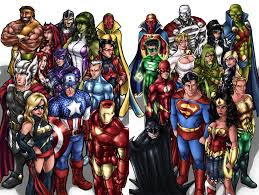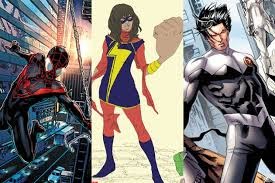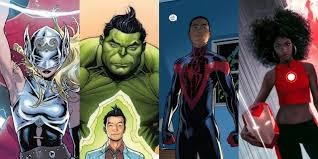This chapter contains three sections:
The Benefits of Comics and Superheroes in the Classroom
The Possibilities are Endless: Superheroes and Narrative Writing
Graphic Novels in ELA Classrooms
The Benefits of Comics and Superheroes in the Classroom
by Mohamed Abouzid
A debate I have had with colleagues in my school is the idea that comics are not considered “literature.” This brings to mind the question: what is considered literature? In the view of my colleagues, they feel that literature is made up of chapter books; comics are not considered literature since they are too focused on images. Students are more concentrated on the pictures than they are on the words. The idea that students cannot analyze comics in the same way that they can Shakespeare limits both students and teachers. For example, I have always been at odds with fellow teachers regarding this debate. Students always lean to graphic novels when told to pick books from the library. So, instead of forcing them to choose different books, why not adapt the curriculum to meet their interests? The idea that one can’t analyze a comic is false. Like all other forms of storytelling, there is plot, character development, and conflict.

image taken from (c) British Library 
image taken from (c) EntertainArt
However, it is not just my colleagues who are against the inclusion of superheros in the classroom. According to an article by Louise Lavery, including superhero films in a course curriculum is problematic. She believes that they promote senseless violence with no basis (Lavery 95). While she is right that these movies all have violence, using that as a basis for a ban is weak, considering many canonical written works also depict violence. To Kill A Mockingbird, Of Mice and Men, and most Shakespearian plays all have violence, and at times can be more graphic than what is presented in superhero films. Lavery continues her argument, writing that “…violence could arguably be classified as gratuitous” (95). While her point is valid, this is why the teacher makes the executive choice of which scenes have meaning and should be focused on within the classroom. Much like how novels have filler scenes, so do movies. It is up to the teacher to show scenes that have meaning; there are scenes of death that have impact in terms of character motivation, theme, and conflict. Of course, superhero films and comics are not replacing written forms of literature. These texts are not without their own flaws, in terms of objectification of women and lack of diversity. However, this genre can still be used as a medium to expand students’ understanding of culture as well as appeal to their interests, which allows for more engagement in classroom activities.
In an article by Lisa A. Gross, Leslie Upson Bradbury, Elizabeth Frye, and Bonnie Watkins, they discuss how a teacher used superheroes to discuss the concept of gravity. This shows how superheroes and comics could be utilized beyond the English classroom; they can be incorporated in other subjects as well. It was fascinating to see how the teacher connected the heros to concepts of earth and gravity. One activity included the students choosing a hero from comics and attempting to explain their origin: “as an Earth-born superhero, Peter Parker must learn how to use his powers, especially those in direct violation of the laws of physics” (Gross 68). Watkins further explains this strategy, in which students discuss hypothetical situations on the moon. Students are asked to explain how Spider-man’s powers and movements on Earth would compare to if he were on the moon. Furthermore, how did Peter’s mobility compare to before getting his power? (Gross 69). This culminated in a storyboard activity where students tracked their calculations about their chosen heroes and how they obtained their powers as well as calculations about to how they moved (Gross 74). Having the students create the work in the form of a storyboard allowed the teachers to track the students’ progress and thinking. This demonstrates the variety of uses for both comics and superheroes in a multitude of subjects. Students are more engaged in the activity since it is a topic of interest to them, all the while still learning from it.
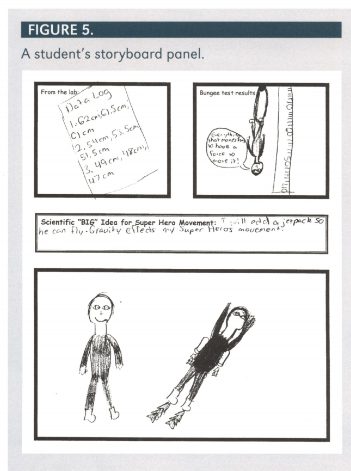
Image taken from Gross, et al. (2016)
Many of these comics discuss or relate to events that happen in the real world. This leaves a lot of opportunities for students to make real life connections, a goal that is pushed in education. Students can also make connections with the characters. They can analyze personality traits and discuss how these characters develop and if they can be considered heroes; for example, having students look deeply at the conflict of a story and deeming how the characters have changed or not based on their experiences. There are plenty of ways that students can explore comics and superheroes in ways that are similar to traditional literature.
Cultural Responsiveness and Modern Society
One of the unique aspects comics can do for students is build their cultural awareness. Tough issues such as race and gender can be introduced through the medium of comics and allow students to explore these ideas. A common criticism of comics and superhero films is the lack of diversity. Looking at a shot of top heroes, it is easy to notice that a majority of them are white with little diversity.
However, this has changed in recent years, with a big push for more representation within the genre. More characters of color and race have been created to fill in the void. There are even more queer characters present as well. This representation gives students even more opportunities to find characters that they can connect to. A Latin American student finally has their own character they can relate to and idolize. It would be interesting to have students explore this history by having them research why there was so little diversity in the genre to begin with and looking at what were some major pushes or comics that led to this movement for diversity. This allows students to explore the society they live in as well as get a better grasp of how race isn’t just regulated to their textbooks. They can see that issues of race and gender translate to all forms of media.
To further this, a teacher can host activities centering around the students creating their own heroes. There may be students whose race or culture isn’t represented in comics. Having students create their own characters gives them a sense of ownership. These characters can be designed to best represent both their heritage and their individuality. Students will be encouraged to look more into themselves and their own background, possibly even developing further appreciation for where they come from and who they are. Allowing students to reinforce their own identities and build an appreciation for it brings literacy beyond written texts and into the real world.
Images taken from WallpaperCave, Black Ship Books, and Typewriter Monkey Task Force, respectively.
To further this, a teacher can host activities centering around the students creating their own heros. There may be students whose race or culture isn’t represented in comics. Having students create their own characters gives them a sense of ownership. These characters can be designed to best represent both their heritage and their individuality. Students will be encouraged to look more into themselves and their own background, possibly even developing further appreciation for where they come from and who they are. Allowing students to reinforce their own identities and build an appreciation for it brings literacy beyond written texts and into the real world.
Classroom Activities Relating to Comics and Superheroes
There are many different activities that can be implemented in the classroom for students. Students will enjoy many of these activities, as they target students’ more artistic side as well as giving them something different from the usual norm.
- Comic Book Show and Tell
- For this activity, students are tasked with creating their own comic strips.They are first given their own comics to read so that they can see how one is developed. Ideally, this will be done before hand with review of the teacher. Once students have analyzed how an author develops a comic, they go on their own and develop their own using those styles. They will then peer edit with their classmates and present their creations to the class. This is a good activity to do before a major project or reading as it gives students an idea of how comics are structured and developed.
- For more information, click here.
- Storyboard That
- This is a free site that you can set up for your classes. Students will create their own storyboards based off stories that have been read. They can turn text like Monster or The Hunger Games into storyboards. This is a great activity for them to focus on certain elements such as conflict, setting, or character development. Students can turn their favorite texts into mini-comics to help them visualize what they have read or are currently reading. Click here to explore Storyboard That!
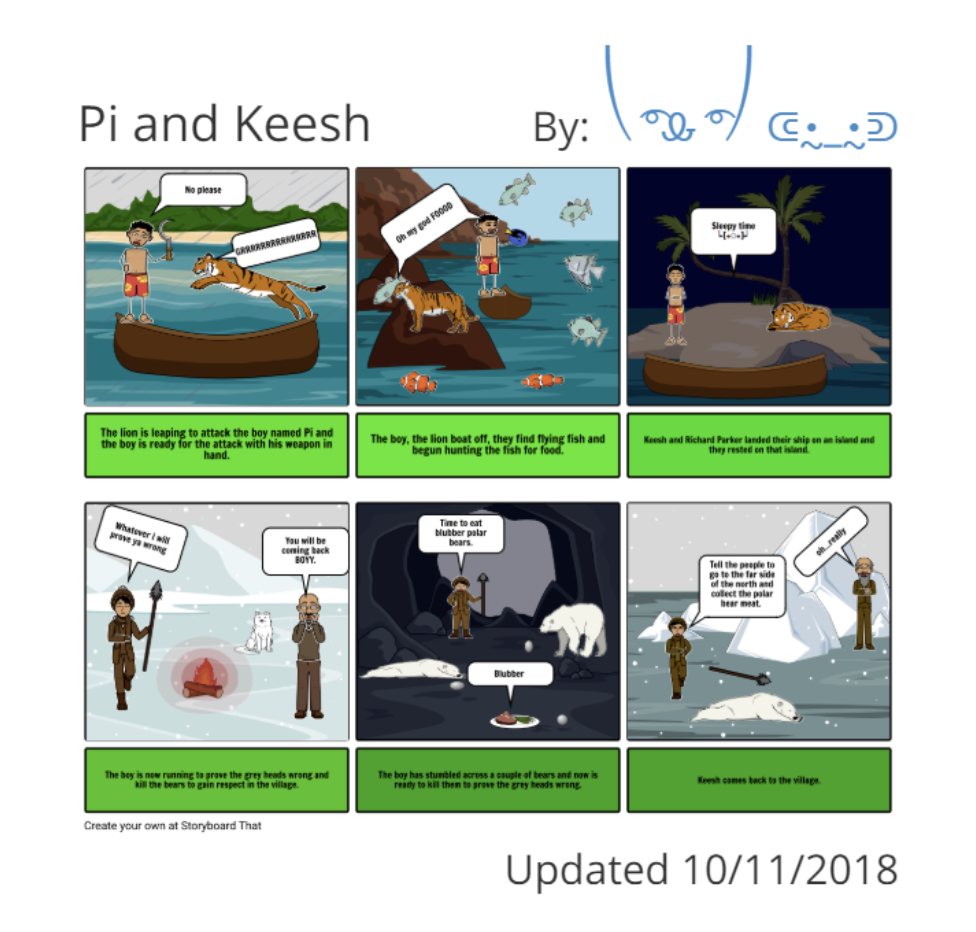
Screenshot taken by Mohamed Abouzid
- Story Maps
- It is a simple activity where students can create their own superheroes and develop a story map explaining how this hero would be able to stop the coronavirus spread. It does lean towards a younger group, but can be modified to meet an older age group.
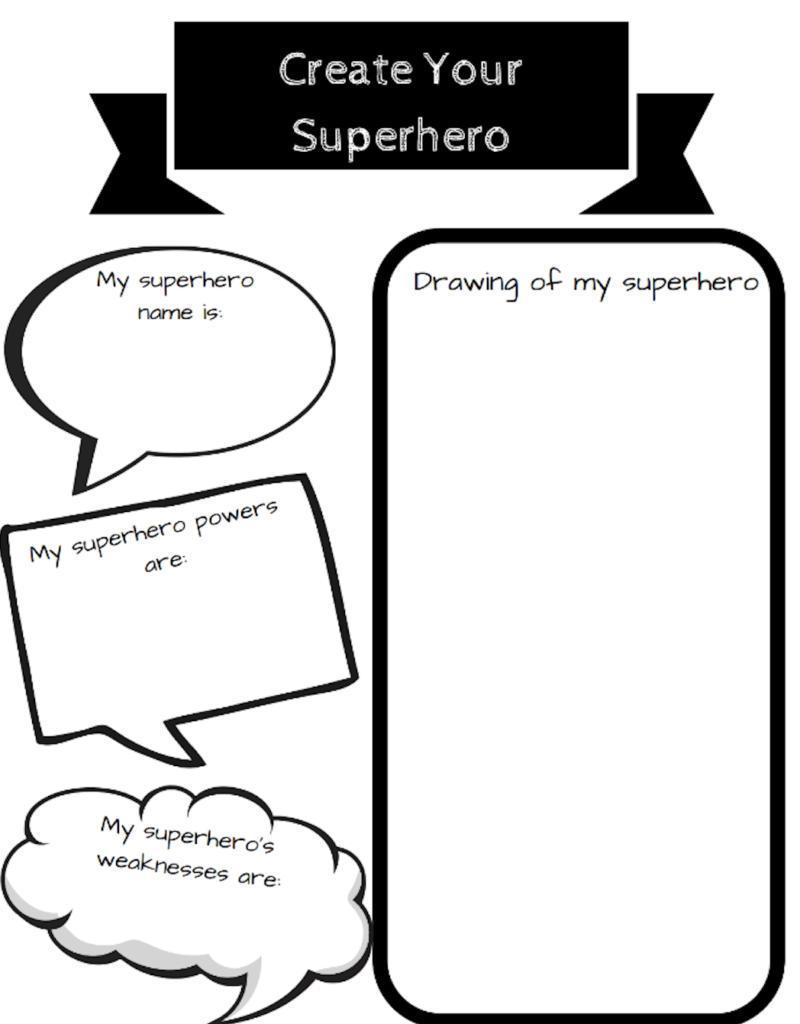
Image taken from Teachers Pay Teachers user (Ms. Rico’s Class)
- Sentence Structure Puzzle
- This is a simple sheet that is best suited for struggling or ELL students. It is a sentence structure puzzle where they have to get Superman from one end of the city to another. It is very simple, but I found it nice and saw some promise with it.
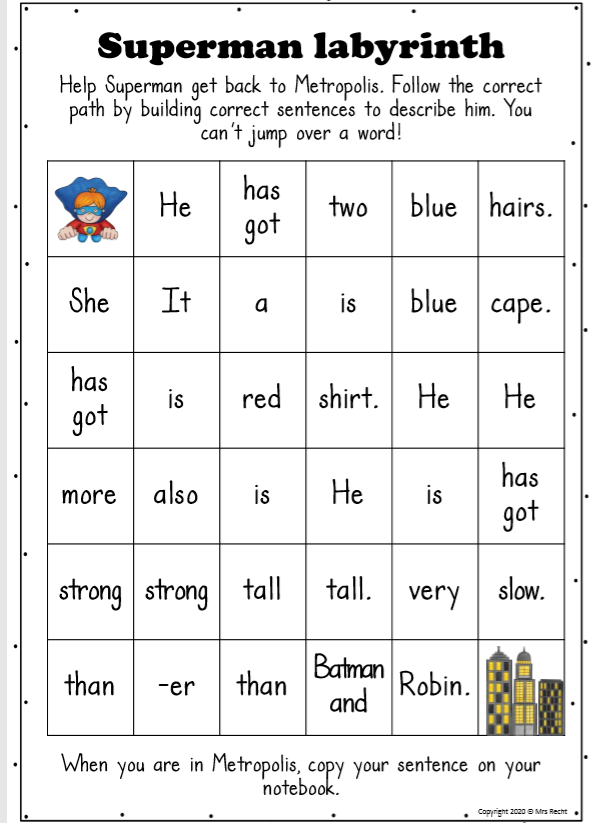
Image taken from Teachers Pay Teachers user (Mrs. Recht’s Virtual Classroom)
- Developing a Story Using Peer Review
- This is a more in depth activity obtained from Teachers Pay Teachers. The focus here is helping students build their storytelling ability by structuring a story in various parts. They split into groups and first begin developing their character. They then structure the events and conflicts the character must overcome. Finally, they draft their writing. This activity helps students practice group work strategies, characterization, and conflict. A rubric is also attached with the activity.
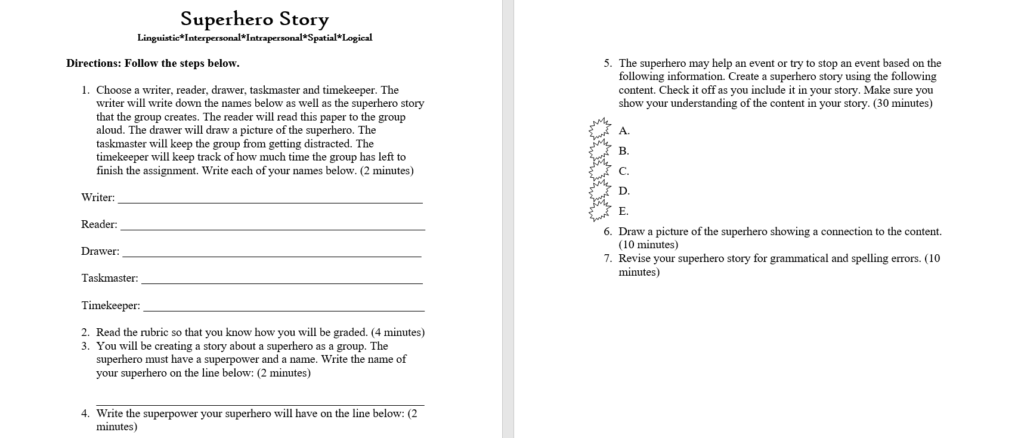
Image taken from Teachers Pay Teachers user (Kasha Mastrodomenico)
The Possibilities are Endless: Superheroes and Narrative Writing
by John Trapani
An ominous wind blows through the empty streets of Gotham. With it comes an improbable fog laden with more than sewage ridden droplets that made it notable to the eyes, skin and nose. The soft paws of every alley cat carried with it a dreadful sense of how the city may have been forever changed. With the city’s hero captured, or worse, there was little doubt that the safety of Gotham’s citizens had been compromised. A decade’s worth of bacterial decay had taken place overnight to Gotham’s already jeopardized sense of hope. Shutters were pulled tight up and down the crumbling apartments. The people trapped themselves inside their own circumstances with despair. I looked up to our hero, even when every outlet turned against him for the countless impossible situations he ran headfirst into. For years I dreamed of fighting alongside him, ready to one day take up his mantle and be that hero that he has delivered through the years. And here I was, creeping through the alleys searching for something I never knew how much I feared until I was within arm’s reach. Sharp tingles of doubt pumped through every vein in my body…
What makes a hero? Is there one generic formula that they follow? I don’t think so. While many do follow a fine-pointed cookie-cutter format, it seems we have begun to recognize that heroes come in all shapes and sizes and with many new and unique qualities that have gone under-appreciated for generations.
So, what is a hero? Is it someone with superpowers who can rush into a burning building and pull the damsel-in-distress out without so much as a singed nose hair? Or the underdog who overcomes impossible feats despite their circumstance? Or, perhaps even, the child who sacrifices and suffers in school because they are home every day taking care of their five siblings and sick mother? Let us take some time to think about some people who are heroes to us and see if we can find something unconventional that you believe makes someone an unappreciated or overlooked hero; think about how other people’s definitions of a hero might be different from your own.
When I teach narrative writing, I love to have students explore a wide array of possible outcomes in every given circumstance. For this reason, I first play a video explaining theoretical dimensions which explores such possibilities titled, “How to Understand the 10th Dimension.” I would then explain to the students how they, as narrative writers, are very much in control of exploring a multi-layered world with the full extent of their imaginations.
Plot-Driven and Character-Driven Stories
I find this video to be an immensely helpful tool to use as a jumping point for students to begin their narrative with either a key character trait or a key plot. The class would look at the example of my own writing above. If this were centered around a character, what would be the character trait that the story is surrounding? Someone who dreamed of being a crime fighting hero. If it were to be a plot-driven story, what is the plot that this story is centered around? The long-time hero is captured and if no one steps up to take his place, the world will plunge into chaos.
The students will explore these differences as well as others between character-driven stories and plot-driven stories. Students would be asked to begin their narrative by choosing three individual traits of a character or three individual plot ideas. Students would have time to explore these and see which one of them makes their imaginations go wild. After having some time to make notes and consider their options, they are told to pick one that they would soon be using for narrative writing. For students who have trouble getting started, I would have a character or plot springboard to help them.
A Character, a Plot, and a World
The students will get into groups of 4. Each student will take the chosen idea of the other 3 students and give them an idea or a possibility of who/what could interact with their story to make something compelling, interesting, and/or meaningful.
- If the student had a character-driven idea, the students would suggest a world for that character based on their character trait.
- If the student had a plot-driven idea, the students would suggest a character trait that would be interesting in that plot.
Students will work together with their peers to complete their individual handouts to get started with a character, a plot, and a world.
The Call to Action
Is a hero born or are they created by circumstance? The students will take a look at what they have written and carefully identify what has made this person a hero and what trials they will need to face. The students will go through the rising action phase of their narrative writing. They will be prompted by possibilities such as, “What could happen to your character that would make something interesting happen because of their character trait,” or “What could happen in your world that would show something really interesting about your plot?” Students can work in their groups to get ideas from one another. The students will be given a handout to fill out that will take them through a series of questions to craft their narrative: “Ok, if that happened, what could the fallout be?”
Writing a Narrative
The class will read about writing a narrative essay, using this website.
The students will be given peer review sheets that will have boxes reflecting the performance of the 5 categories in good narrative writing. After reading a partner’s narrative, they will check the boxes for “Good!” “Awesome!” “This needs another look” or “I didn’t see you use this.”
Graphic Novels in ELA Classrooms
by Diana Gendron
It has been said that a picture paints a thousand words. Strong visual representations can quickly and easily bridge gaps in student knowledge and understanding. Most educators recognize that multiple points of entry are vital for a well-functioning classroom across all disciplines. Students should be met where they are and given differentiated materials and scaffolds that support their learning. In this section of our class handbook, I will be exploring the benefits and limitations of graphic novels in ELA classrooms. More explicitly, I will be exploring their potential as a means of narrative writing and self-expression.
People, some of whom are students, learn in different ways. Many people are visual learners. Graphic novels offer an alternative to some texts by eliminating the need to describe each character’s appearance, the setting and other aspects of a story that can be shown with drawing. In addition, physical and emotional reactions can be portrayed in a way that can be more visceral and understandable to a reader than a conventional text.
Liz is a ninth grade student who has some processing issues. When asked how she learns best, she said “Too many words are not good. I need pictures and things read to me.” She said that reading Romeo and Juliet is impossible for her. She’s been watching the 2013 screen adaptation and that has helped her to understand which parts of the play are meant to be funny and to help her understand the plot in general. I delivered our graphic novel version of Romeo and Juliet to her with hopes that it makes the story more compelling and relatable to her.
Graphic novels are often dismissed by school administrators as being trivial or juvenile. However, they can serve as differentiated material and/ or scaffolds for students such as Liz. They can also be incredibly helpful to students who are new to a region or country. When I was student-teaching at a high school in Flushing, the student population was very high performing. Many were the children of immigrants or immigrants themselves. Almost none spoke with an accent but I came to understand that there were references made in literature they didn’t understand. When reading the willow cabin soliloquy in Twelfth Night, these high-performers knew a willow was a tree. However, showing an image of a weeping willow helped them to better understand the significance of this particular tree in Shakespeare’s work.
Graphic novels can also be powerful tools for narrative writing. For students who find writing daunting, the option to write a graphic novel can be a powerful tool for self expression. Not having to rely on words for every component of a scene can be very liberating for some. The setting can be shown easily. If the scene takes place on a beach, yellow sand, blue water and a sun in the sky can be easily rendered. What a character looks like may be difficult but a tear or angry eyebrows can quickly make apparent how someone is feeling.
Equally, some students may be daunted by the idea of creating a graphic novel. Some doubt their artistic abilities or worry that their work may be subpar. There are various websites available that can support students in this endeavor: Pixton, Storybird, MakeBeliefsComix and ToonDoo to name a few. Students can also be reassured that they will not be judged (or graded!) by the quality of their drawings. This can be a great means of expression for school projects as well as a tool for them to understand and cope with life issues, emotions and problems in a healthy way.
Graphic novels are, for some, a new form of narrative writing. They can provide a different means of self expression. Graphic works can be a powerful tool for all readers and can provide alternate materials for students who struggle with traditional texts. They can also provide a break from traditional learning which can be welcome immediately after high-stakes tests or other stressful periods. As educators, it is important that we have a way to reach out to our students in a way so that each can connect with class material. Graphic novels can provide all the depth and beauty of more traditional writing while also including students who are often left behind.
Recommended Reading:
Original Works:
- Maus by Art Spiegelman
- Persepolis by Marjane Satrapi
- The Watchmen by Alan Moore and Dave Gibbons (may be too explicit for some)
“Translated” (Adapted) Works:
- Many plays and different renditions of the works of William Shakespeare
- Speak by Laurie Halse Anderson
- The Stand by Stephen King

